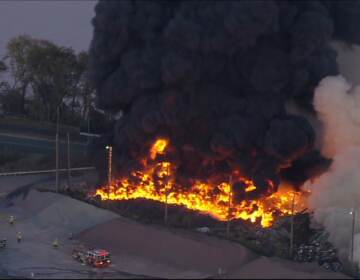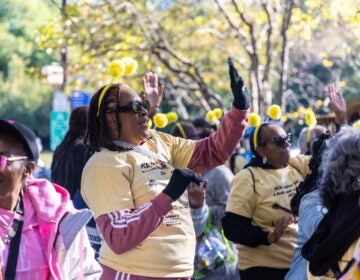After a junkyard fire, Philly sent an emergency alert. Less than 2% of affected residents got it
Southwest Philadelphia residents say warnings about health hazards from a junkyard fire needed to come sooner and more directly.
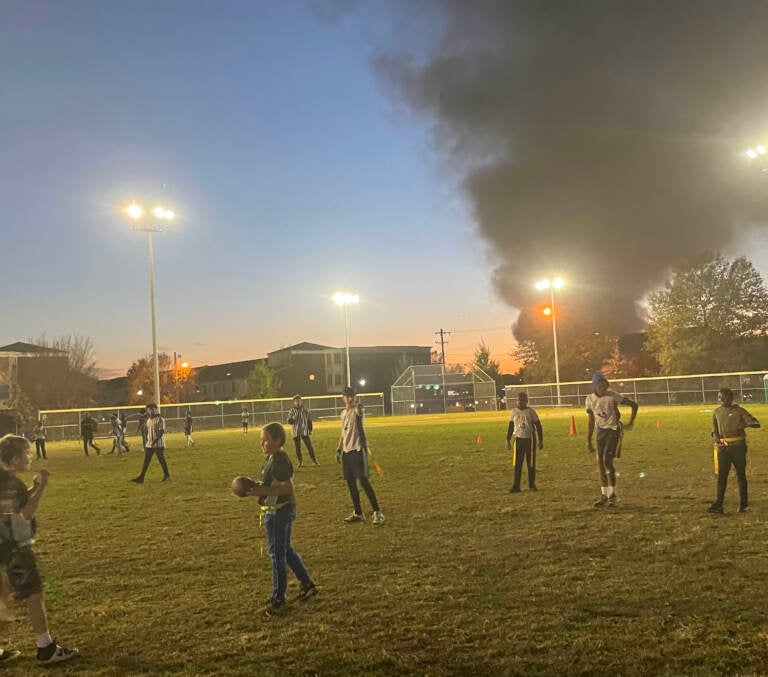
Young people play football at Lanier Park on Tuesday after a junkyard fire sent smoke into the air. (Photo provided by Alexandre Imbot)
Charles Reeves Jr. was setting up for flag football at Lanier Park when he noticed dark smoke rising from across the Schuylkill.
“At first it was going straight up in the air,” he said. “Black smoke.”
He wondered whether he should let the teens in the league run by his nonprofit, Resident Action Committee II, play that evening, or whether it would be safer to cancel the game.
“These kids only play once a week. They want to play,” he said. “They gonna be here, and they faithful. So now I gotta weigh it, because I’m responsible right now.”
Reeves didn’t hear any emergency siren or see any alert on his phone about the two-alarm fire in Southwest Philadelphia Tuesday. So he told the kids to put on disposable or fabric COVID masks, and he let the game go on. The Philadelphia Fire Department reported the fire — caused by burning piles of tires, wood, and other construction debris that towered four to five stories high at Delaware Valley Recycling, Inc. — was “under control” around 5:30 p.m., just as Reeves’ flag football game got underway.
But as the kids ran up and down the Grays Ferry field, smoke increasingly filled the sky, shrouding the lights on the field in a haze. It burned the eyes of some of the junkyard’s closest neighbors in Southwest Philly, and caused them to vomit and struggle to breathe.
“I think about it all night,” Reeves said. “Did I make the right decision?”
A notification about the fire went out to Philadelphians who had signed up for the city’s emergency alert system, called ReadyPhiladelphia, at 4:30 p.m. Tuesday. But Reeves did not get this information, because he didn’t know about the program.
But even if he had signed up, Reeves would not have learned whether the smoke posed health risks to the young people in his care. Tuesday’s alert simply described the location of the “multiple-alarm fire,” noted smoke was visible across much of South Philly and Center City, and advised people to “avoid the area due to [the] amount of PFD personnel and apparatus.”
Marilyn Howarth, director of the University of Pennsylvania’s Center of Excellence in Environmental Toxicology, said the alert should have included a health advisory, telling people — particularly young children, people with medical problems, lung or heart disease — to stay inside. Without such a warning, Reeves and other people had no way to know that young people should not have been running around outdoors in the smoky conditions, in part because your body takes in more air while exercising than it does while at rest.
“I think it would have been better if they had decided that it was time to maybe play another day,” she said.
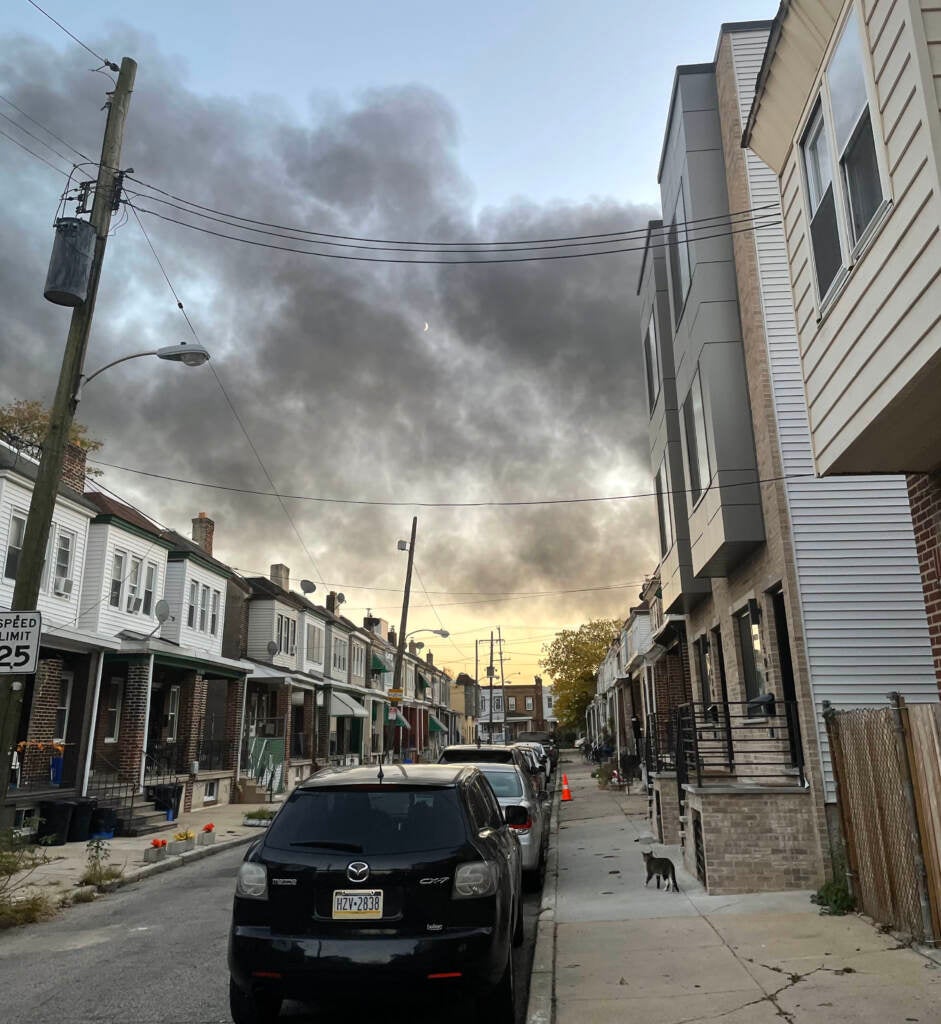
It wasn’t until the next day that the City’s Department of Public Health posted information online about health risks from the fire. Health officials advised people in smoky areas of the city Wednesday to limit their time outside and those with heart or lung problems to avoid exerting themselves. It was the guidance Reeves needed a day earlier at his flag football game.
“With no information, that’s not fair,” he said. “If I made the wrong decision, then what? These parents trust me. They trust me with their babies.”
Reeves said it was an especially hard decision, because he considers football practice a “safe space,” where young people can get away from other dangers, like the gun violence epidemic that he and others in Southwest Philadelphia are working to combat.
“My young people on this side are getting shot and killed,” he said. “So I gotta weigh the good stuff with the bad. I try to give them the best possible opportunity to succeed.”
Reeves was not alone in his quest for information. ReadyPhiladelphia is run by the city’s Office of Emergency Management and it sends notifications by email, text, voicemail or a mobile phone application. It’s the primary one-to-one system to tell residents about things like severe weather, SEPTA delays, and unexpected disturbances such as fires. But in order to receive these notifications, people must know about the program and sign up. Roughly 31,300 people city-wide are signed up for email alerts — just under 2% of the population — and around 17,200 people are enrolled for text alerts only, according to City officials.
The ZIP code where Reeves leads flag football, 19145, has around the same usage rate as the city as a whole. With a population of more than 48,000 people, 853 are signed up for ReadyPhiladelphia. The 19142 zip code closest to the fire that broke out Tuesday has even fewer people signed up. Of the more than 28,000 people who live in the ZIP code, just 133 — less than half a percent — are signed up for ReadyPhiladelphia.
Mixed messages about safety risks
The day after the fire when Reeves was still thinking about whether he had made the right decision at the game, city officials reported that the Health Department tested the smoke and found no toxic compounds “at levels that would threaten the public’s health.” In messages that went out online on the city’s media channels and through the press, officials said these compounds were “thousands to hundreds of thousands of times” below levels the EPA sees as potentially causing long-term harm.”
But a ReadyPhiladelphia alert at just before 3 p.m. that day said simply, “Health Dept reports NO toxic chemicals harmful to health found in air samples from SW Philly fire.” A link followed, to a Health Department tweet with more nuanced phrasing and health guidance.
Fire Update: Samples taken from the fire have found NO toxic chemicals at levels that would be harmful to your health. However, there is still particulate matter in the air from the smoke. (1/2)
— Philadelphia Public Health (@PHLPublicHealth) November 10, 2021
Howarth, who subscribes to ReadyPhiladelphia, found the message that there were no toxic chemicals harmful to health in the smoke misleading.
“That couldn’t possibly be true,” she said. “It’s not possible that you have a fire of that magnitude, and no toxic chemicals harmful to health would be found in air samples that were correctly done. … That is why firefighters bring their own air. When complex infrastructure burns, it is toxic. Toxic chemicals are released.”
Howarth said tire fires tend to release chemicals known to cause cancer, including some polyaromatic hydrocarbons and benzene.
The Health Department’s press release said the biggest risk came from higher than normal levels of tiny particles known as PM 2.5. These particles, less than 4% the diameter of a human hair, can get deep into people’s lungs and even enter their bloodstream, causing heart attacks, aggravating asthma and making it hard to breathe.
The smaller the particle, the longer it can stay airborne and the farther it can travel. Particulate matter larger than 10 micrometers tends to deposit on the ground downwind of polluting sites, Howarth said. But particles smaller than 2.5 micrometers, or PM 2.5, can travel hundreds of miles.
Cloth masks used to reduce the spread of COVID-19 do not protect against the small particles in wildfire smoke, according to the CDC, but N95 and KN95 respirators can help.
“I think there’s no question that anyone in the immediate environment of the fire certainly would have been exposed to high levels of particulates and perhaps higher than ideal levels of other chemicals,” Howarth said. “As the smoke drifted away, it does tend to disperse, and the levels are lower.”
All Health Department air quality monitors showed “normal” levels of particulate matter as of Thursday morning, officials said. They announced that widespread risk from the fire had passed, though localized areas might still be experiencing smoke or haze.
“Because even short-term exposures to high PM2.5 levels can trigger exacerbations among people with heart and lung problems, we take this event very seriously,” a city spokesperson said in a statement.
‘No emergency communication”
Reeves, president of the Tasker-Morris Neighbors Association, is no stranger to industrial pollution. He’s lived in Grays Ferry — close to the PES refinery, which shut down after a massive explosion in 2019 — for 60 years.
“We’ve been living here so long, we’ve been treated like this so long, that it becomes second nature,” he said. “When I looked at the smoke … I’m thinking, here it goes again.”
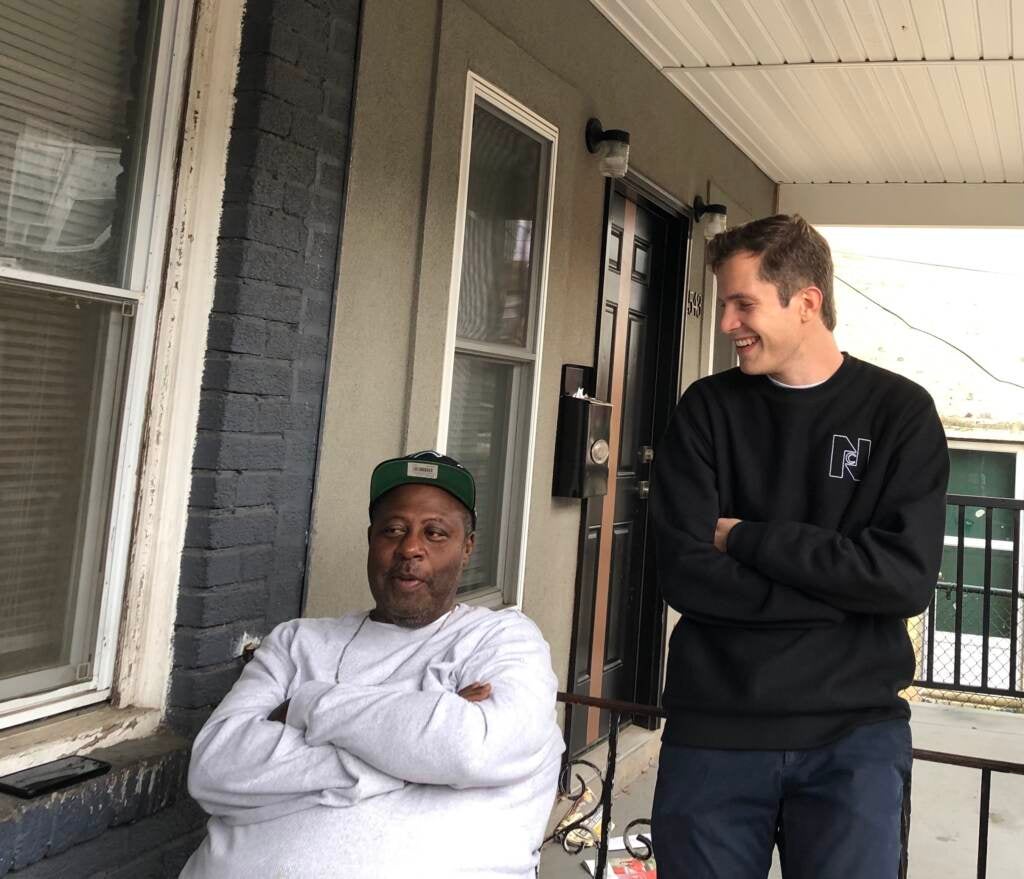
After this week’s incident, Reeves wants answers.
“I want to know exactly what I was breathing,” he said.
The City tested for 15 different toxic compounds, including benzene, according to test results officials provided to WHYY, but did not post publicly. All compounds showed up at concentrations far below the level to which the Occupational Safety and Health Administration believes a worker can be exposed for 8 hours a day, 40 hours a week, for a working lifetime without adverse health effects, officials said.
City Councilwoman Jamie Gauthier, whose West and Southwest Philly district includes the recycling center, said in a statement Wednesday that many of her constituents experienced physical reactions to the smoke. She said she planned to meet with city agencies to ensure Tuesday’s incident does not happen again.
“There is no question in my mind that this should have been handled differently,” she wrote in a statement posted to social media. “As the fire was burning, there was no emergency communication from the city on what was happening, the potential risks, and how residents should keep themselves safe. In the midst of a dangerous event that went on for hours, … that is unacceptable.”
“After the last couple years,” she added, “it should be painfully obvious that transparent, regular communication is key to maintaining public health.”
Alert system reached less than 1% of residents in the area closest to fire
Jacqueline Newsome lives off Eastwick Ave. in Southwest Philly, less than a half mile from Delaware Valley Recycling, Inc. She put tape around the edges of her front door Tuesday evening, to try to stop the smoke from entering her home. Still, her eyes burned, and she struggled to breathe. Newsome, who is 69 and lives alone, has asthma and allergies — and worried she might end up in the hospital.
“The smell was coming in the house, and I started getting hoarse,” she said. “It felt like my chest was trying to close up on me.”
Newsome learned about the fire first from neighbors, and then from watching the news.
She had never heard of the ReadyPhiladelphia system, and is not likely to sign up. She says she only uses her cell phone to make calls and her computer to play games.
“It’s a shame that we don’t hear anything to alert us on certain things that go on in this area,” Newsome said.
She wishes city officials had gone door-to-door to communicate with people about the fire.
City officials said they communicated with elected officials, businesses, and institutions in the affected areas, but that the Health Department does not have the capacity to go door-to-door checking on residents. Officials say they are reevaluating their emergency communications protocols in response to feedback.
“We recognize that many people prefer to hear from us directly, and we are revisiting our risk communications plans and protocols to ensure proactive communications as part of our planning for future emergencies, including the use of strategies to reach community leaders and institutions directly,” a spokesperson wrote in a statement.
In the meantime, elected leaders are calling for more accountability and tighter restrictions for operations like Delaware Valley Recycling, Inc.
State Rep. Rick Krajewski described the site as an “environmental disaster waiting to happen.”
“It is unconscionable that we continue to let private scrapyards like this one function essentially unregulated,” he wrote on Twitter Wednesday. “It is not a coincidence that scrapyards and junkyards are placed in Black and brown neighborhoods.”
A spokesperson said the city will work with “partners across the city” to mitigate the risk of future fires, particularly involving tires.
Reeves wants to see the city not only prevent similar incidents, but actually get crucial and timely information to the people who need it.
“This can’t happen like this every time,” he said. “There’s got to be a better system.”
To sign up for alerts through ReadyPhiladelphia, text READYPHILA to 888-777.
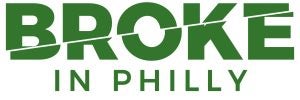 WHYY is one of over 20 news organizations producing Broke in Philly, a collaborative reporting project on solutions to poverty and the city’s push towards economic justice. Follow us at @BrokeInPhilly.
WHYY is one of over 20 news organizations producing Broke in Philly, a collaborative reporting project on solutions to poverty and the city’s push towards economic justice. Follow us at @BrokeInPhilly.

Get daily updates from WHYY News!
WHYY is your source for fact-based, in-depth journalism and information. As a nonprofit organization, we rely on financial support from readers like you. Please give today.




